The people, projects and ideas transforming the market
Explore industry updates and insights from green building leaders who are creating the buildings and communities of the future.
Editor's Choice
Take a look at some of the best articles from the archives.















